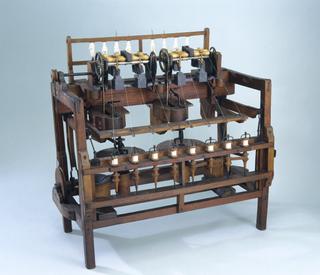
Arkwright's Water Frame, 1775
1775
Improved spinning machine (water frame), by Sir Richard Arkwright, England, 1775.

Rotative Steam Engine by Boulton and Watt, 1788
1788
Boulton and Watt Rotative Beam Engine - the 'Lap' engine. This is the oldest essentially unaltered rotative engine in the world. Built by James Watt in 1788, it incorporates all of his most important steam-engine improvements. The engine was used at Matthew Boulton’s Soho Manufactory in Birmingham, where it drove 43 metal polishing (or ‘lapping’) machines for 70 years.
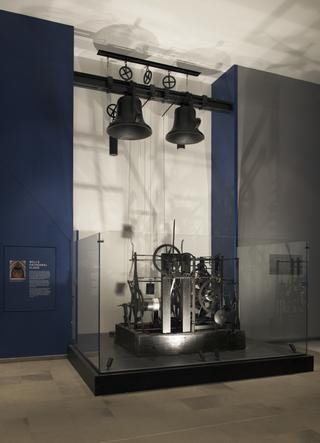
Wells Cathedral clock, 1392
1392
Wells Cathedral clock, England, 1392

Cotton Bale Breaker
1911
Cotton bale breaker, made by Platt Brothers & Co. Ltd, Oldham, 1911 and used in the Textile Technology Department at UMIST.

Wrapping block
circa 1920
Wrapping block, made by John Nesbitt, Manchester, c.1920.

Ring spinning frame
1901
Ring spinning frame, made by Platt Brothers & Co. Ltd, Oldham, 1901, and used at Brooklands Mill, Leigh.
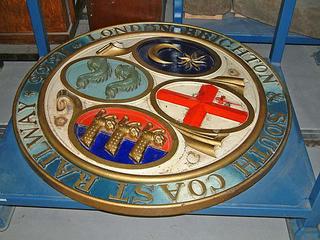
Cast iron plaque from Queenstown Road Bridge, Battersea, London, 1865
1865
Bridge plaque, London Brighton & South Coast Railway, cast iron, 1865, bearing crest of LB&SCR, Queenstown Road Bridge, Battersea, London. Diameter: x 45 in ( x 1143 mm).

wagon repair plate
Wagon Repair Plate, Lancashire & Yorkshire Railway, "Gen'ly Repaired by SM & BP Ltd. L & YR 12739, 3-1952", cast iron oval, white on black, from Shell BP tank wagon 1981-7003.

wagon repair plate
Wagon Repair Plate, Lancashire & Yorkshire Railway, "Gen'ly Repaired by SM & BP Ltd. L & YR 12739 3 - 1952", cast iron oval, from Shell BP tank wagon 1981-7003.

Cast iron fender, North Eastern Railway
Fender, North Eastern Railway, cast iron, embossed 'NER', no provenance.
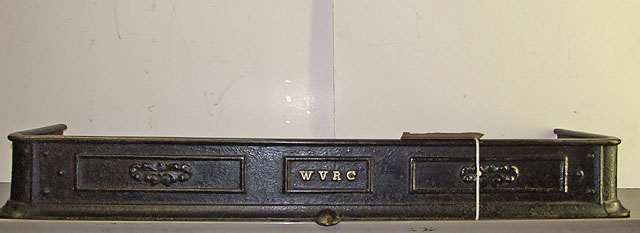
Cast iron fender, Waveney Valley Railway
Fender, Waveney Valley Railway, cast iron, embossed 'WVRC', no provenance.
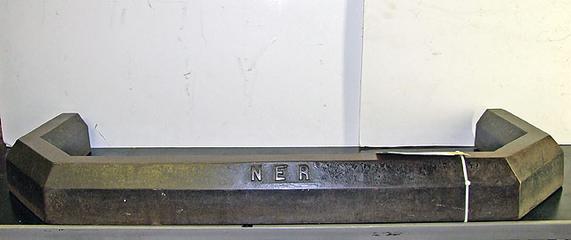
Fender, North Eastern Railway
Fender, North Eastern Railway, cast iron fender with 'NER' embossed on front.

Down Pipe from Maldon Witham & Braintree Railway
1846-1859
Down pipe, Maldon Witham & Braintree Railway, 1846-1859, cast iron water pipe with hopper head, painted green, marked MWB and ECR (Maldon Witham & Braintree and Eastern Counties Railway), ex Maldon East Station.

Railway Street Sign, York
1930-1960
A City of York Council sign for 'Railway Street', removed when it was renamed 'George Hudson Street' in 1971.
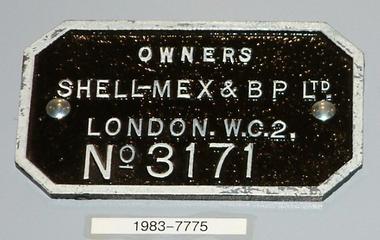
Wagon owners plate, Shell-Mex & BP
1901
Wagon owners plate, "Owners Shell-Mex & BP Ltd, London WC2, No 3171", cast iron rectangle, from BP Oil Tank Wagon 1981-7003.

Railway footbridge from Percy Main Colliery station
Footbridge; North Eastern Railway; Cast Iron; ex Percy Main station
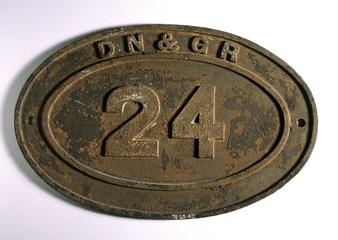
dundalk newry & greenore railway bridge plate 24
Bridge plate, Dundalk Newry & Greenore Railway, DN&GR 24, cast iron, oval.

Slotting machine
1835
Slotting machine, made by Sharp Roberts and Co., Manchester, 1835. Constructed from cast iron on sort of arched frame design. Table with cross and front to back movements placed in middle with slotting arm above it. Three stepped pulley and hand wheel on drive cross shaft to gears on left with a secondary shaft working the slotting arm. Operating arms are missing from the cam to the rachet levers.
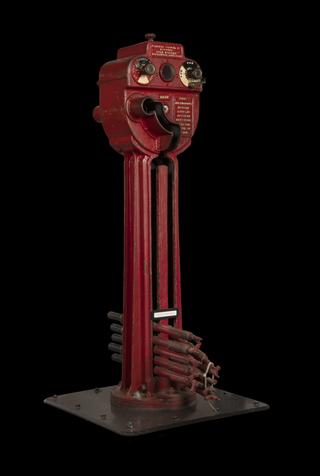
Webb & Thompson Train Staff Instrument
Train staff instrument, Webb & Thompson type, No 2020, cast metal pillar type, painted red, with staffs, Kippax-Garforth line.
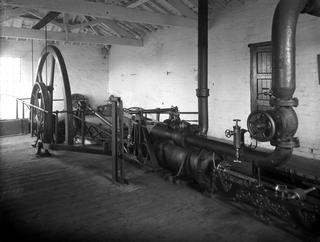
Swannington Incline Winding Engine, Leicester & Swannington Railway, 1832
1832
Winding Engine, Leicester & Swannington Railway, Swannington Incline Winding Engine, 1832, horizontal.

Double beam engine model
1840-1851
Working model, (scale 1:10) of a 240 H.P. beam engine by Benjamin Hick, Bolton, for John Marshall's Temple Mill, Leeds, 1840. This model was shown at the Great Exhibition of 1851.

Water Pipe
1890 - 1900
Cast iron water pipe taken from Liverpool Road, Manchester. It connected the Liverpool Road Station site with the mains water supply. It probably dates from the late 1890s. It was extracted by United Utilities during water pipe replacement which took place in Manchester city centre 2007-2009.

Early hand-powered lock stitch sewing machine
Early Wheeler and Wilson hand-powered lock stitch sewing machine of a design of about 1867; this model was made around 1885.

Peel, Williams & Peel steam engine
1846
Six-column beam engine made by Peel, Williams & Peel, Manchester, in 1846. It was used at Thomas Redfern’s file-making factory in Portwood, Stockport, where it was in use for 62 years. The engine has a 12-inch x 20-inch slide valve cylinder, a single plate cast iron beam and a 9-foot flywheel. It works at a pressure of 25 lbs per square inch and runs at 50 revolutions per minute. The engine developed 10 indicated horsepower, the steam consumption being about 40 lbs per indicated horsepower per hour, equivalent to 6 lbs of coal per horsepower per hour.

Columnar Engine, 1862
1862
Small columnar engine built by the company of Maudslay, Sons & Field, to drive their models displayed at the London International Exhibition, 1862.
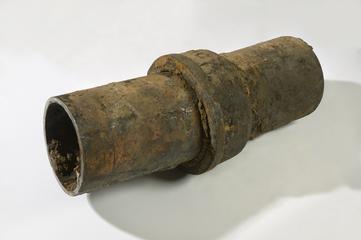
Water pipe from Water Street, Manchester
1890-1899
Cast iron water pipe taken from Water Street; probably dates from the late 1890s; extracted by United Utilities during water pipe replacement which took place in Manchester City Centre 2007-2009
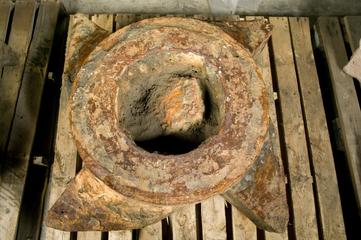
Large cast iron cam from Pollard Street archaeological excavations of Peel, Williams & Peel Co. Soho foundry
1839-1887
Large cast iron cam, 1839-1887, Peel, Williams & Peel Co. Soho Foundry on Pollard Street, Ancoats, Manchester.

Drawing frame
1901
Drawing frame, made by Platt Brothers & Co. Ltd, Oldham, 1901, and used at Brooklands Mill, Leigh.
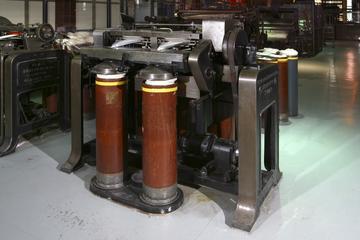
Drawing frame
1901
Drawing frame, made by Howard Bullough Ltd, Accrington, 1901.

Cast iron sign, England/Scotland border
Cast iron sign, London & North Eastern Railway, England/Scotland border sign from Deadwater, red letters supported by a white beam, a rose and a thistle, a pike or halberd separates the 2 names at the border.

Wagon owners plate, Shell-Mex & BP
1901
Wagon owners plate, "Owners Shell-Mex & BP Ltd London WC2. No 3171", cast iron from BP Oil Tank Wagon 1981-7003.

Lancashire & Yorkshire Railway post plaque
Gate post plaque, Lancashire & Yorkshire Railway, cast iron plaque mounted on wood, from gate post of Exchange Station, Liverpool, L & YR picked out in gold on black background, mounted on wood. Overall: 620 mm x 307 mm x 45 mm.
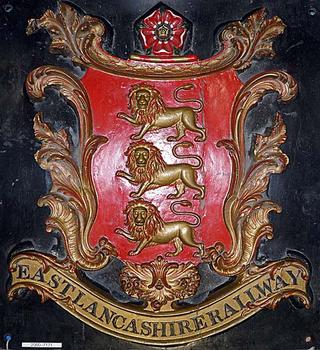
Gate plaque, East Lancashire Railway
Gate plaque, decorative, coat of arms of East Lancashire Railway, cast iron and bolted onto an iron plate, bearing an ornamental shield with three gold lions similar to those of the Duchy of Lancaster surmounted by the red rose of Lancaster, from entrance gates to Bury Bolton Street Station.

Ornamental casting, Midland Railway
Ornamental casting, Midland Railway, ornamental cast iron Wyvern from spandrel, no provenance.
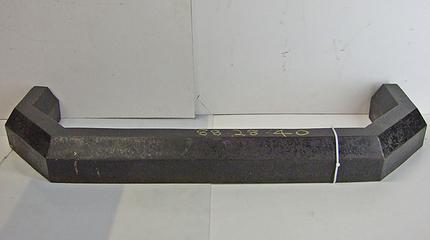
Fender, cast iron, plain square - edged, no company markings
Fender, cast iron, plain square - edged, no company markings

Domestic Sewing Machine for chain stitich
1868
Cleopatra chain-stitch domestic sewing machine made to an 1867 design, by Newton Wilson and Co., 144 High Holborn, London, England, 1868.

Model of a Power Loom for Plain Weaving
1857
Model, scale 1:3, of a power loom for simple plain weaving made by Messrs. Sevill and Woolstenhulme, Oldham, Manchester, England, 1857.

Micrometer type mechanical comparator
1855
Whitworth millionth measuring machine in a case for comparing components against standard inch bars; made in 1855.
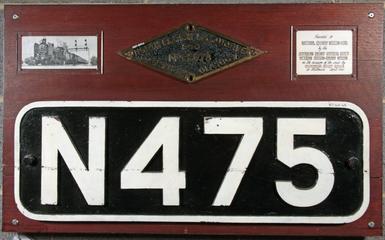
N475 locomotive numberplate & worksplate, Australian Railways
Locomotive numberplate, Australian Railways, "N475", cast iron numberplate mounted on wood with photograph and worksplate.

Piston and Rod, from Newcomen Pumping Engine 'Old Sarah'
1815
Piston and Rod, Piston Rod Cap and Chains from Newcomen Pumping Engine "Old Sarah" Newmarket Silkstone Colliery, Stanery near Wakefield, Yorkshire.

Intermediate Frame
1907
Intermediate frame, made by Platt Brothers & Co. Ltd, Oldham, 1907, and used at Roy Mill, Royton.
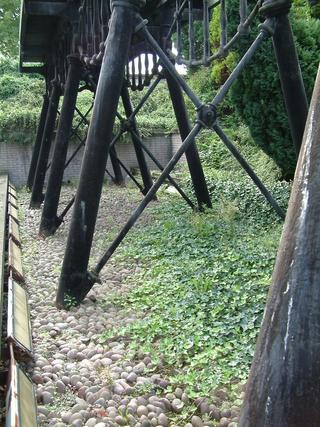
Bridge used to span the River Gaunless at West Auckland
1823-1825
Bridge, Stockton & Darlington Railway, cast iron bridge reputed to be the first iron railway bridge, used to span the River Gaunless at West Auckland, designed by George Stephenson, built by John & Isaac Burrell, Newcastle upon Tyne between 1823-1825.
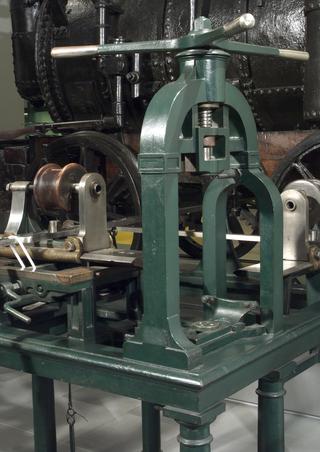
Boring machine, Yard No. 642
1804-1807
Boring machine, Yard No. 642
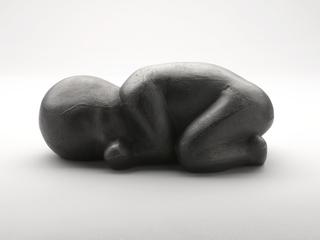
Iron Baby
1999
A cast iron sculpture, 'Iron Baby', Edition AP III/III, by Antony Gormley, England, 1999.

Whitworth Planing Machine
circa 1842
Planing machine, made by Joseph Whitworth & Co. of Manchester, 1842. Belt drive, three pullies, one loos in the middle, to drive the lathe in either direction. Table worked by the worm screw and nut. Parts of the automatic cross feed to the tool holder are missing, as is the original tool holder which probably was the reversing type. This machine was originally in the LNWR Crewe works, reputedly used for making horn blocks for axles. Presented by A Bebbington & Son, Culland Street Works, Crewe.
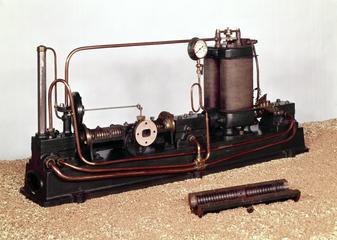
Parsons' steam turbine generator, 1884
1884
Parsons' original Steam Turbine generator, with spare guide ring and fan, by Clarke, Chapman, Parsons & Co.,1884
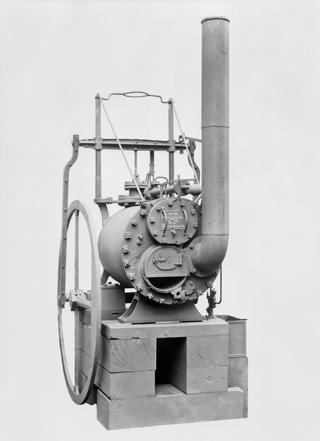
Trevithick's High Pressure Steam Engine and Boiler, c. 1806
1805-1806
Trevithick high pressure stationary engine built by "Hazledine & Co., Bridgnorth", no. 14, c. 1806, with timber staging
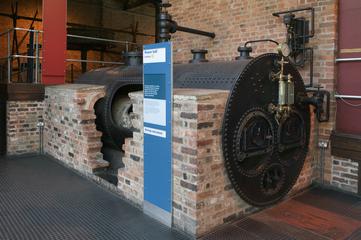
Lancashire Boiler
1889
Lancashire boiler, made by W & J Galloway & Sons Ltd, 1889.

Nasmyth's Steam Hammer
1845-1855
Nasmyth steam hammer, by James Nasmyth, Patricroft, Salford, Manchester, England, 1845-1855. It was installed at the Royal Mint until 1933.
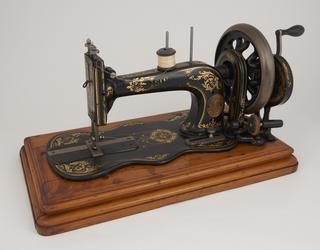
Singer 'New Family' sewing machine, 1865-1883.
1865-1883
The Singer 'New Family' lockstitch sewing machine, made between 1865 and 1883.